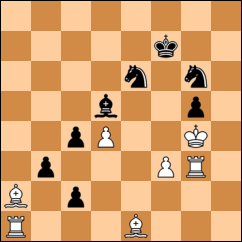Draw
Section B.2.
Michael Pasman (Israel)
wKg4,Ba2,e1,Ra1,g3,Pd4,f3/bKf7,Ne6,g6,Bd5,Pb3,c2,c4,g5
1.Bb1! Creating battery
1.Bd2? b2 2.Rgg1 bxa1Q 3.Rxa1 Ngf4 4.Rc1 Nxd4 5.Kxg5 Nd3 6.Rf1 Nb3 7.Be3 Nb4 8.Bb1 c3–+
after 1.Rg1!? black wins in this way : 1…Nxd4 2.Rf1 b2 3.Bc3 bxa1Q 4.Bxa1 Ne2 5.Bb2 Ngf4 6.Kxg5 Nd3 7.Ba3 Nc3 8.Ra1 and now for example 8…Ke6 9.f4 Kf7–+ white is in zugzwang 10.f5 Ne4+ 11.Kg4 Nd2 12.Kg5 Nf3+ 13.Kg4 Kf6–+
1…Ne5+!
1…cxb1Q 2.Rxb1 Kf6 3.Rg2 Nh4 4.Rf2 Nf4 5.Bc3 Be6+ 6.Kg3 Nf5+ 7.Kh2 Nd5 8.Ba1=
1…Nxd4 2.Bxc2 bxc2 3.Bd2 Ne5+ 4.Kh5 Nb3 5.Ra7+ Ke6 6.Bxg5 Bxf3+ 7.Kh4=; 1…c1Q 2.Bxg6+ Battery 2…Kxg6 3.Rxc1 Nf4 is similar to main line with white pawn on d4 instead of e5 4.Rg2! Nxg2 but this time simpler 5.Bc3! draws (5.Bd2 Nf4 6.Re1 Be6+ 7.Kg3 Bf5) 5…Nf4 (5…Ne3+ 6.Kg3) 6.Re1 Be6+ 7.Kg3= because black has no Nd5 move, f.e. 7…Bf7 (7…Bf5 8.Re5) 8.Re5 Nd5 9.Ba1 c3 10.Rxd5 Bxd5 11.Bxc3=
2.dxe5 c1Q 3.Bg6+! Implementing battery 3…Kxg6 4.Rxc1 Nf4! Mate threat 5.Rg2! 5.Rg1? Ne2 6.f4 Be6+ 7.Kf3 Nxg1+ 8.Kg2 Ne2–+
5.Rh3? Be6+ 6.Kg3 Ne2+! 7.Kh2 Nxc1–+
5…Nxg2 6.Bd2!
6.Bc3? Nf4 7.Re1 Be6+ 8.Kg3 Nd5 9.Ba1 c3 10.Rc1 c2 11.Kf2 Nb4 12.Ke2 Na2 13.Bb2 Nxc1+ 14.Bxc1 Bd5–+
6…Nf4! Switchback
6…Nh4 7.e6 Bxe6+ 8.Kg3 Bd5 9.Bc3 Bxf3 10.Re1 Bd5 11.Re5 Nf5+ 12.Kg4 Nh6+ 13.Kg3=
6…Be6+ 7.Kg3 Nf4 8.Bxf4=
7.Bxf4 c3!
7…Be6+ 8.Kg3 c3 9.Rxc3 b2 10.Rc1!=
7…gxf4 8.Kxf4 b2 9.Rg1+ Kf7 10.Ke3 white is in time to stop the pawns
8.Rxc3! b2 9.Rc1! Be6+! 10.Kg3 gxf4+ 11.Kh4! bxc1Q= Model Stalemate with blocked f3 and e5 pawns

